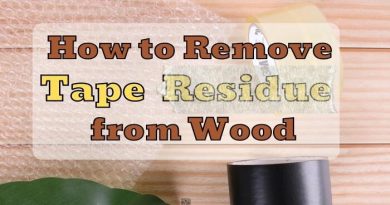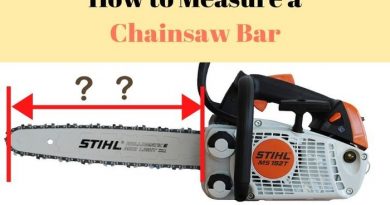How to Remove Linseed Oil from Wood [4 Unexpected Ways]
Hardened linseed oil forms a solid layer that is difficult to remove from wood but simply painting over is usually not an option. Removing linseed oil from wood is a simple process and there are several ways to do it properly.
How to Remove Linseed Oil from Wood
Tools necessary to remove linseed oil from wood:
- Rag
- Protective gloves, mask and goggles
- Rough paper with medium and fine texture
- Chemical solvents (turpentive)
- Hard bristle brushes
- Rough sponge
Here is how to remove linseed oil from wood step by step:
- Wipe dust off the wood surface with a damp cloth. Allow the wood to completely air dry.
- Pour turpentine on a cloth and rub over the surface. It acts as a degreaser and dissolves old layers of linseed oil from the wood.
- Apply the turpentine to the wood in a circular motion until the linseed oil begins to dissolve.
- Let the turpentine sit for 10 to 20 minutes.
- Wash the wood surface with hot soapy water.
- Use a rag to scrub the remaining linseed oil from the wood. Rinse well with lukewarm water and allow the wood to air dry.
- Flip the fabric over and rub the surface again, repeating until no more residue comes out on the fabric.
4 Alternative Methods to Remove Linseed Oil from Wood
How to Remove Linseed Oil from Wood – METHOD # 1
Traditional sandpaper can be used to remove the linseed oil from wooden furniture.
Before starting work, wear a mask and special protective goggles against small dust particles. These, in fact, could irritate the eyes and lungs. As far as possible, protect the metal parts of the wood furniture with adhesive tape.
As a rule, a simple eccentric sander with a 125mm plate is sufficient if you want to work on a small piece of wood or another piece of furniture, for example.
However, as soon as you want to treat larger areas such as a floor, I recommend using an eccentric sander with a 150mm sanding pad if possible. The time saved with the larger sanding pad is not insignificant here.
- Sand the surface with medium-grit sandpaper to remove the layer of wood where linseed oil has penetrated, working with the grain.
- Once you’ve removed everything, the wood will be a shade lighter underneath.
- Wipe the surface with a damp cloth to remove any wood particles and reveal any stains that may have been lost.
- Allow surface to dry completely, then follow with fine grit sandpaper, working with the grain.
- This for the areas where the grain of the sand occurs and eliminate the remaining areas of penetration of linseed oil.
- Wipe the surface with a damp cloth and allow it to dry.
- Run your hand over any dry surface, gritty feel, raised areas or unevenness.
- Sand again until you are sure the surface is clean and evenly even.
How to Remove Linseed Oil from Wood – METHOD # 2
If the surfaces are really large, working with paint strippers or lye is not recommended. This simply creates too many harmful vapors and a lot of chemical waste that also has to be disposed of properly.
However, sandpaper may not be enough. The oil finish, in fact, penetrates deeply into the wood, crystallizes and occupies the pores of the fiber. Therefore, to remove linseed oil from wooden furniture need specific chemical solvents.
Super Easy Ways To Learn Everything About How Does Sandblasting Work!
Strippers and lye are not exactly health or environmental friendly, but they are considered to be quite powerful. In fact, linseed oil paint can usually be softened with at least one of these chemical agents and then scraped off.
However, older oil paints can have many different compositions, which is why their chemical solubility is also partially different from one another. Obtain an agent that is generally suitable for coatings with oil as a binder.
Then simply try it out on a limited area, always observing all safety measures and the instructions for use. If it works, you can also remove the rest of the linseed oil coating.
How to Remove Linseed Oil from Wood – METHOD #3
In some cases, linseed oil that is not completely dry can get rid off with a hot air blower so that it can be removed more easily.
If necessary, a normal hair dryer on the highest setting will do. To remove linseed oil from wood using hair dryer proceed as follows:
- Hold the switched on hair dryer about 10 cm away from the surface.
- Move it back and forth over an area of a few square centimeters.
- Pick up a spatula.
- Use it to check whether the linseed oil paint can be removed while blow drying. – Scrape off the peeled paint from the surface.
- Then turn to the neighboring area.
- Be careful not to scorch the ground as you work.
Good ventilation and breathing protection are also recommended when doing this job because you never know what types of vapors will be released from heating old paint.
After all, there is no additional toxic chemistry added to the waste.
Discover here how to dissolve wood glue with these 4 amazing techniques.
How to Remove Linseed Oil from Wood – METHOD #4
Orange oil
Large surfaces such as parquet floors that have been oiled with chinese wood oil too intensively can be treated with an orange oil.
This is spread over the wood and, after a short exposure time, polished with a rough sponge or a polishing machine.
In this way, the excess oil is worked off. Any abrasion residues are picked up with a lint-free and absorbent cloth.
Let the surface dry for 24 hours before polishing again with a rag.
Step 1
If you use orange oil cleaning concentrate, apply it with a brush.
Step 2
Let it work for about 10-20 minutes, then wipe it off with a cloth.
Then repeat the procedure with the eccentric sander and polishing felt.
Step 3
If the sticky layer is a bit older, I soak the cleaning cloths with orange oil concentrate and place them on the affected areas. I then let it work for about 1 hour.
Step 4
Then rub it off again with the cloth and then remove the remaining oil residue with the polishing felt.
Step 5
If necessary, the application must be repeated several times. It is also advisable to have several polishing felts ready for the eccentric sander, as some of them become clogged with oil.
Often you can clean them a little with EV thinner, but when the surface is saturated, a new felt has to be put on the machine.
Check this tutorial where I describe how you can easily remove oil based stains from wood!




